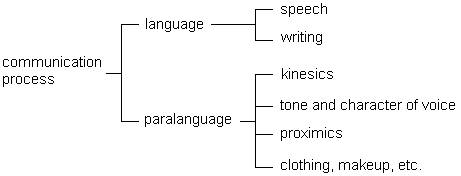Kinesics
The most obvious form
of paralanguage is body language
or kinesics
 . This is the language of gestures,
expressions, and postures. In North America, for instance, we commonly use our arms
and hands to say good-bye, point, count, express excitement, beckon, warn away, threaten,
insult
etc. In fact, we learn many subtle variations of each of these gestures and use them situationally. We use our head to say yes or no, to smile, frown,
and wink acknowledgement or flirtation. Our head and shoulder in
combination may shrug to indicate that we do not know something.
. This is the language of gestures,
expressions, and postures. In North America, for instance, we commonly use our arms
and hands to say good-bye, point, count, express excitement, beckon, warn away, threaten,
insult
etc. In fact, we learn many subtle variations of each of these gestures and use them situationally. We use our head to say yes or no, to smile, frown,
and wink acknowledgement or flirtation. Our head and shoulder in
combination may shrug to indicate that we do not know something.
 |
|
Test your knowledge
of North American
body language. Look at the couple walking
together. What
does it mean to be so close
with their arms around each other this way?
Could they
be strangers?
Click the button to see
if you are correct.

|
While the
meaning of some gestures, such as a smile, may be the same throughout the world, the
meaning of others may be completely different. For example, spitting on another person is a
sign of utmost contempt in Europe and North America but can be an affectionate blessing if done in a
certain way among the Masai of Kenya.

Tone
and Character of Voice
The meaning of speech can
also be altered significantly by tone and character of voice. In English, the
simple sentence "I'm here." can have very different
connotations depending on whether it is spoken with a voice that is high, low, quick,
slow, rising, falling, whispering, whining, yelling, or sighing. Similarly, the
sentence "Are you here?" has a different meaning if
it spoken in an rising tone in contrast to a descending one. Give it a try...
Proxemics
When we speak to another
individual or group, the distance our bodies are physically apart also communicates a
message. Proxemics
 is the study of such interaction distances
and other culturally defined uses of space. Most of us are unaware of the
importance of space in communication until we are confronted with someone who uses it
differently. For instance, we all have a sense of what is a comfortable interaction
distance to a person with whom we are speaking. If
that person gets closer than the distance at
which we are comfortable, we usually automatically back up to reestablish our comfort
zone. Similarly, if we feel that we are too far away from the person we are talking
to, we are likely to close the distance between us. If two speakers have different
comfortable interaction distances, a ballet of shifting positions usually occurs until one
of the individuals is backed into a corner and feels threatened by what may be perceived
as hostile or sexual overtures. As a result, the verbal message may not be listened
to or understood as it was intended.
is the study of such interaction distances
and other culturally defined uses of space. Most of us are unaware of the
importance of space in communication until we are confronted with someone who uses it
differently. For instance, we all have a sense of what is a comfortable interaction
distance to a person with whom we are speaking. If
that person gets closer than the distance at
which we are comfortable, we usually automatically back up to reestablish our comfort
zone. Similarly, if we feel that we are too far away from the person we are talking
to, we are likely to close the distance between us. If two speakers have different
comfortable interaction distances, a ballet of shifting positions usually occurs until one
of the individuals is backed into a corner and feels threatened by what may be perceived
as hostile or sexual overtures. As a result, the verbal message may not be listened
to or understood as it was intended.

In Latin America, the comfortable (ideal)
interaction distance for talking about personal topics is often
significantly closer than among
non-Hispanics in the U.S. and Canada.
Comfort in interaction
distance mostly has to do with the distance between faces that are looking directly at
each other. Most people do not have the same feeling about physical closeness if
they do not have eye contact. In a crowd or an elevator, people usually choose not
to look at anyone in order to avoid feeling uncomfortably close.
 |
| Japanese avoiding eye contact in
a crowd |
The nature of
the message communicated also affects interaction distances. Average comfortable
distances Among North Americans are shown in the following table:
|
Distance
Between Faces |
Tone of Voice |
Type of Message |
| very close (3-6") |
soft whisper |
top secret or sensual |
| close (8-12") |
audible whisper |
very confidential |
| neutral (20-36") |
soft voice, low
volume |
personal subject
matter |
| neutral (4.5-5') |
full voice |
non-personal
information |
| across the room (8-20') |
loud voice |
talking to a group |
stretching the limits
(20-24' indoors and
up to 100' outdoors) |
loud hailing voice |
departures and
arrivals |
| Derived from The
Silent Language by Edward Hall (1959) |
Whispering and shouting generally get your
attention more than speaking with a normal voice. Children learn this
important fact at a very early age.
In addition
to specifying comfortable interaction distances, culture tells us when and how it is
acceptable to touch other individuals. In North America, culture generally
discourages touching by adults except in moments of intimacy or formal greeting (hand
shaking or hugging). This informal rule is most rigidly applied to men. If
they hold hands or kiss in public, they run the risk of being labeled homosexual and
subsequently marginalized socially. Similar culturally defined patterns of physical
contact avoidance are found in most of the cultures of Asia and Northern Europe. In
Southern Europe, the Middle East, and Latin America, much more physical contact
usually is
expected and desired.
Cultural
Use of Space
Culture also tells us how to
organize space in such a way as to control the nature of interaction. In North
American corporate offices, for instance, the boss is usually physically isolated in a
very separate private room. This tends to minimize his or her personal contact with
ordinary workers. In contrast, Japanese offices commonly are set up with the boss's
desk at the end of a row of pushed together desks used by subordinate employees.
This maximizes his interaction with them.
 |
|
 |
| Typical
North American Office |
|
Typical
Japanese Office |
A court room
similarly alters behavior. In the United States, the judge usually wears a black robe
and sits behind an elevated desk. The other desks and chairs in court are positioned
so that all attention is focused on the judge. This intentional setting makes
those present feel respectful and subservient to the judge, thereby making it
easier for him or her to control the proceedings.
Culture also guides our
perception of space by defining units of it. In the industrial world, space is
divided into standardized segments with sides and position. Acres and city lots with
uniform dimensions are examples of this in the United
States. Our property boundaries are referenced to such
segments of space. As the density of population increases, the importance of defined
spatial boundaries grows. Land owners in densely occupied neighborhoods have been
known to get angry enough to kill each other over disputed fence lines between their
properties. In less dense rural areas of the American West, where people own ranches
of hundreds and even thousands of acres, the movement of a fence
three feet one way or
another is rarely of consequence.
Cultural
Use of Time
Culture tells us how to
manipulate time in order to communicate different messages. When
people appear for an appointment
varies with the custom, social situation, and their relative status. In North
America, if you have a business meeting scheduled, the time you should arrive largely
depends on the power relationship between you and the person who you are meeting.
People who are lower in status are expected to arrive on time, if not early. Higher
status individuals can expect that others will wait for them if they are late.
For instance, most people who have medical appointments are expected to
arrive early and to wait patiently for their doctor to see them rather than
the other way around. An
invitation to a party is an entirely different matter. It is often expected that
most guests will arrive "fashionably late." It generally takes a North
American child at least 12 years to master these subtle cultural aspects of time. By
5-6 years old, they usually only know the days of the week, the difference between day and
night, morning and afternoon, meal and nap time. By 7-8 years old, most can
consistently use the clock to tell time. However, it is not until about 12 years or
older that they begin to know the situational aspects of time, such as when to arrive at a
party.
When
people come together with very different cultural expectations about
time, there is a potential for misunderstanding,
frustration, and hurt feelings. This could occur, for instance, if a
Brazilian businessman does not arrive "on time" for a meeting with a
potential North American customer in New York and fails to give an apology
when he arrives. For the Brazilian, time may be relatively "elastic" and the
pace-of-life a bit slower. He believes that he was sufficiently
prompt for the scheduled business meeting, having arrived within a half hour
of the appointment. It is not surprising that he is astonished and
offended when he is treated coldly by the North American who also feels
slighted by what he perceives as rudeness. Compounding the situation
is likely to be differences in their comfortable physical interaction
distances. This dismal scenario can be avoided, of course, by
foreknowledge about the other culture and a willingness to adopt a
cultural relativity approach.
The old saying "when in Rome do as the Romans do" is still good advice.
Communicating
with Clothes
| |
 |
Papua New Guinean
man
wearing a penis sheath |
Throughout the world,
clothing has multiple functions. It is used to provide protection from
the elements. It also is worn for modesty, usually to prevent
others from seeing specific parts of one's body. However, the parts of
the body that must be covered vary widely throughout the world. For
instance, the man from New Guinea shown in the picture would feel undressed
in public if he did not have the narrow gourd sheath over his penis
tied in an erect position. Throughout most of the rest of the world,
this would be viewed as a
highly inappropriate style of dress to say the
least. Some clothing is worn to
provide supernatural protection. Wearing a Christian cross or a St. Christopher
medal often are thought to have just this effect. Wearing a lucky shirt to take an
exam is also relying on supernatural assistance.
People in all cultures use
clothing and other forms of bodily adornment to communicate status, intentions, and other
messages. In North America, we dress differently for business and various
recreational activities. Likewise there are styles of clothes that are worn to
sexually attract others. There can be great subtlety, especially in women's
clothing. It can communicate that a woman wants to be considered sexually
neutral. On the other hand, it may be meant to be seductive, innocent but alluring,
etc. Women in the Western
World usually are much more knowledgeable of and concerned with
subtle nuances in messages communicated by clothes than are men. At times, this
leads to awkward errors of interpretation of female intentions on the part of men.
Of course, clothing styles also are intended to communicate messages to members of the
same gender.
Long before we are
physically near
enough to talk to people, their appearance announces their gender, age, economic class,
and often even intentions. We begin to recognize the important cultural clues
for this at
an early age. The vocabulary of dress that we learn includes not only items of
clothing but also hair styles, jewelry, makeup, and other body decoration such as
tattoos. In most cultures, however, the same style of dress communicates different
messages depending on the age, gender, and physical appearance of the individual wearing
it.
What do the clothing,
hair style, makeup,
and body language of the young woman
in the photo communicate to you?
Now think
of a middle-aged
businessman
with the
same clothing, hair style, makeup,
and body language...
Do you have a different
reaction?
|
|
 |
|

|
|
| Spanish policemen
|
Putting on certain types of
clothing can change your behavior and the behavior of others towards you. This can
be the case with a military uniform, doctor's white lab coat, or a clown's costume.
For instance, it is likely that the Spanish policemen in the photo are more assertive and
aggressive when they wear their uniforms. Likewise, others are more likely to follow their directions.
Most
uniforms are consciously symbolic so that they can rapidly and conclusively communicate status.
For instance, the ribbon, crown, and scepter leave little doubt that the young woman in
the photo on the left below is a beauty queen.
The ribbons and other insignias on
the U.S. sailor's uniform can tell even a stranger about his status, authority, and military
experience. Similarly, the unconventional hair styles
and clothing of the English "punkers" are essential aspects of their uniforms.
In all three cases, it is necessary to know what these culturally defined
symbols mean in the context that they are used in order to understand what is
being communicated.
 |
|
 |
|
 |
|
Beauty queen |
|
U.S. military
insignia |
|
English "punkers"
in their "uniforms" |
|
|
|
|

|
Dyak
woman
from Borneo |
|
There are many forms of body
decoration other than clothes that are used around the world to send messages. These
include body and hair paint, tattoos, decorative scaring and branding, perfumes, and even
body deformation.
When children are very
young, their bodies are still physically moldable to a degree. Some cultures have
taken advantage of this fact to bind their head or feet. The result can be elongated
heads and tiny stunted feet. When orthodontists put braces on teeth, they are
essentially doing the same thing--deforming or reforming a part of the body to make it
more attractive. Soft tissue can be altered as well. Holes in ears for
decorative rings can be progressively enlarged over years with
thicker and thicker
posts so
that ultimately huge spools, plugs, or heavy rings can be inserted (as in the case
of the Dyak
 woman from Borneo shown in the photograph). This has been a sign of
beauty among some indigenous peoples of Mesoamerica, South
America, and Southeast Asia. The same
thing was done to the lip in a few cultures of Africa and the Amazon Basin of South
America.
woman from Borneo shown in the photograph). This has been a sign of
beauty among some indigenous peoples of Mesoamerica, South
America, and Southeast Asia. The same
thing was done to the lip in a few cultures of Africa and the Amazon Basin of South
America.
 Ancient
Marks--tattoos,
scarification and other forms of body decoration Ancient
Marks--tattoos,
scarification and other forms of body decoration
from many cultures around the world.
This link takes
you to a new
webpage. To return here, you must
click the "back" button
on your
browser program.
(length = 11 mins 6
secs) |
Gender
Differences in Paralanguage
When traveling to other
societies, it is important to understand that there are likely to be significant gender
differences in paralanguage in addition to distinctions in clothes and adornment. In North America,
for instance, men generally prefer face to face conversations and maintain direct eye
contact longer. In contrast, women often converse standing side by side but closer
together than is typical of men. Male hand shakes tend to be firmer. North
American women usually are more restrained in their use of bold gestures but use more
facial expressions (especially smiles) and are more skilled in interpreting them.
In Japan, women most often
speak with an artificially high pitch, especially when conversing with men in a business
or official setting. This is part of the general deference traditionally shown to
men. However, recent research indicates that the pitch of female voices has begun to
lower. It has been suggested that this change is connected with the increased
economic and political clout of Japanese women.
Summary
The human communication
process is more complex than it initially seems. Much, if not most, of our messages
in face to face contact are transmitted through paralanguage. These auxiliary
communication techniques are highly culture bound. Communication with people from
other societies or ethnic groups is fraught with the danger of misunderstanding if their
culture and paralanguage is unknown to you or ignored.

To further explore these
hidden dimensions of communication around the world, check out the selected
bibliography.














